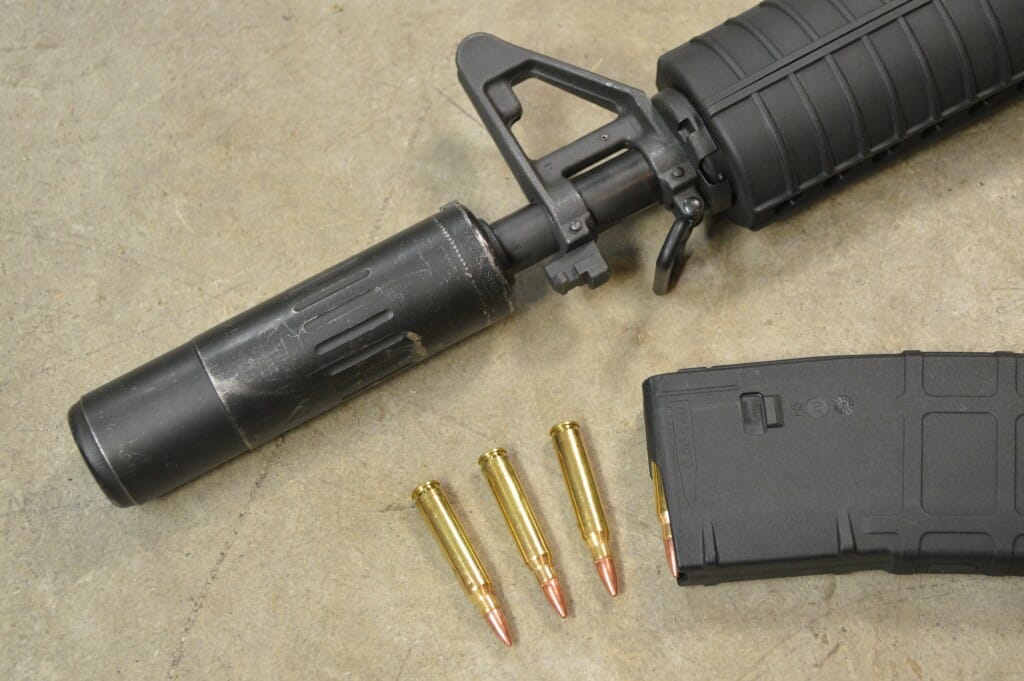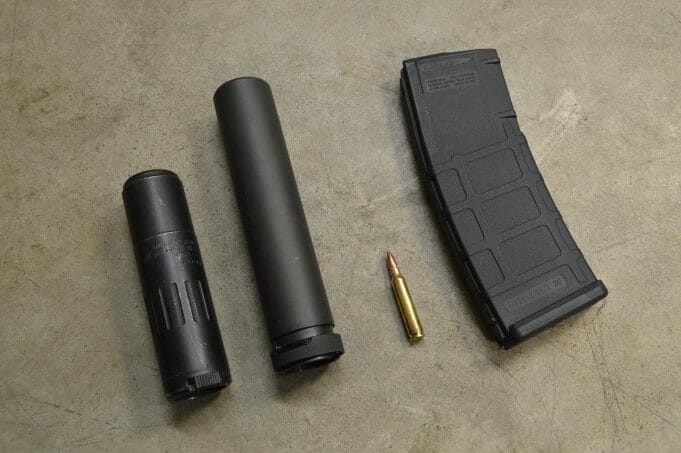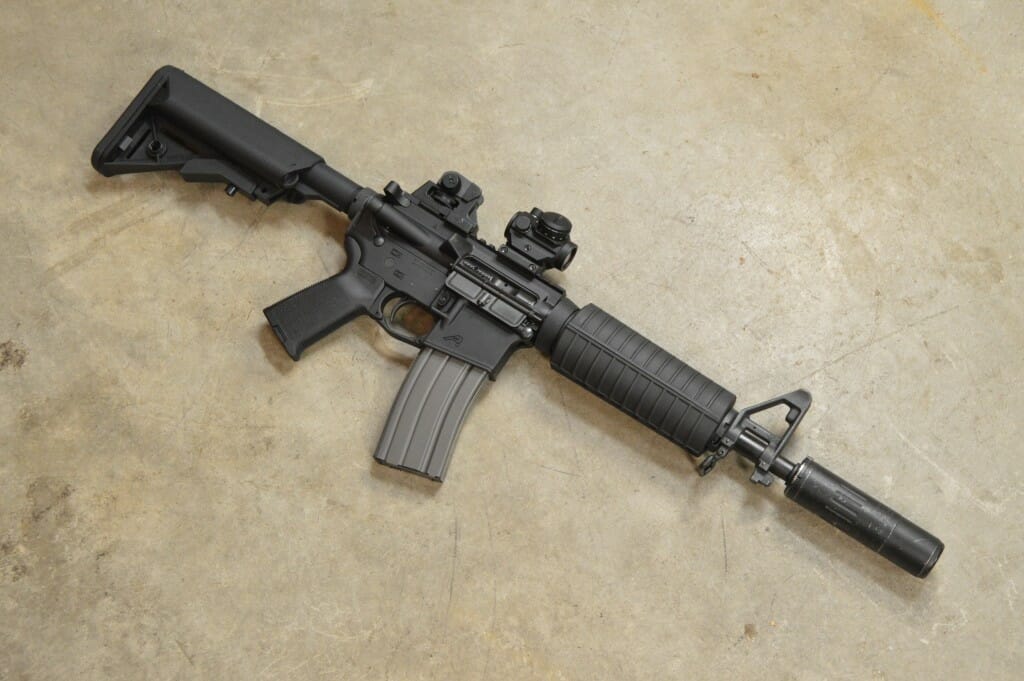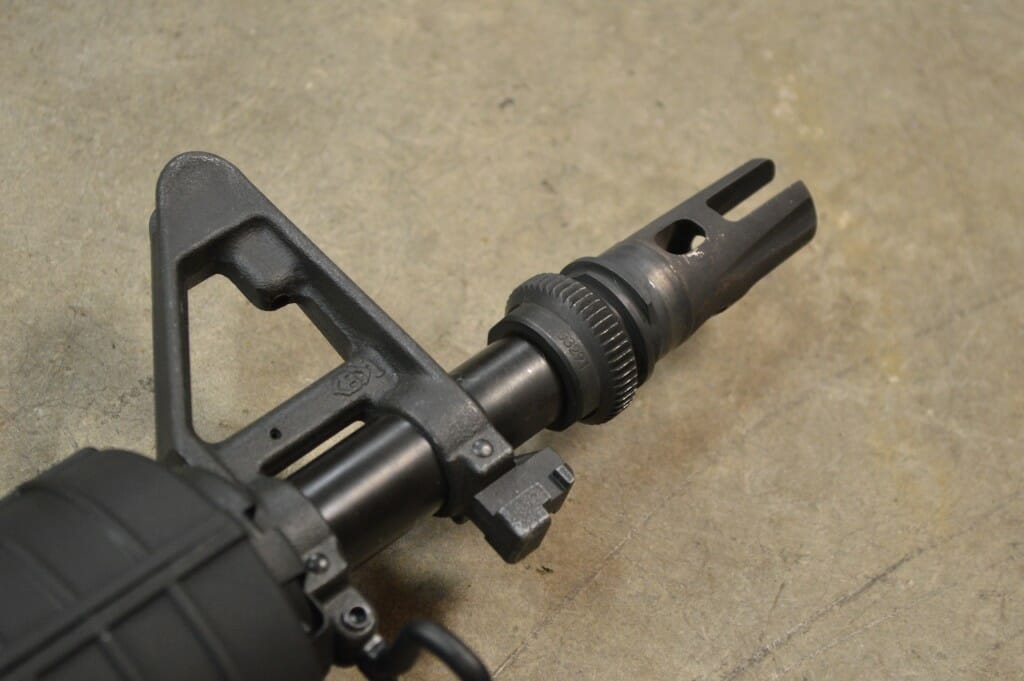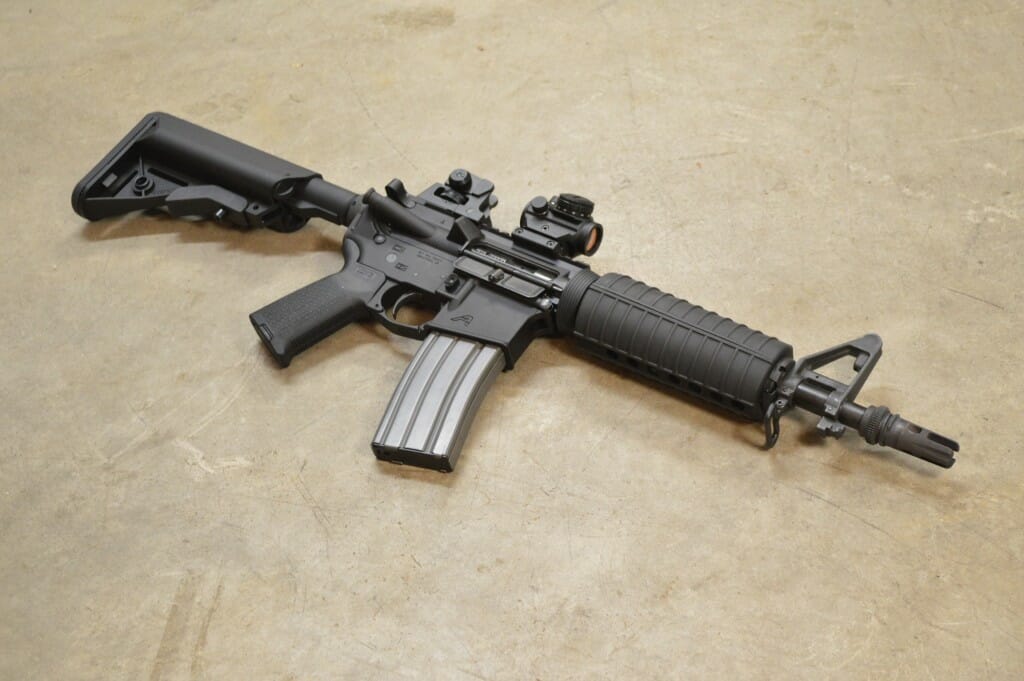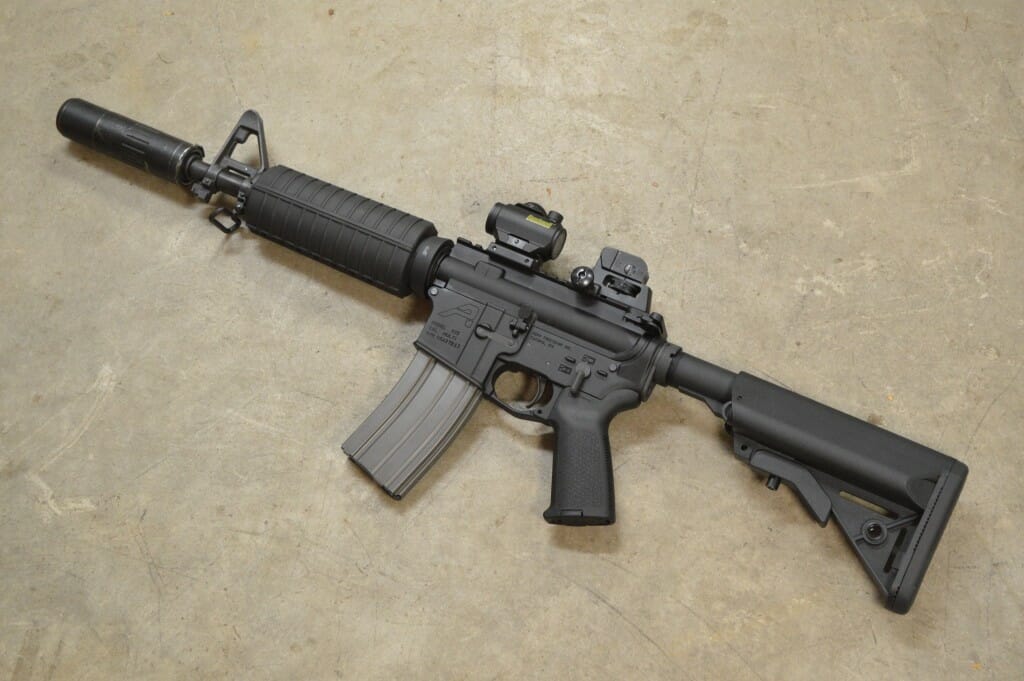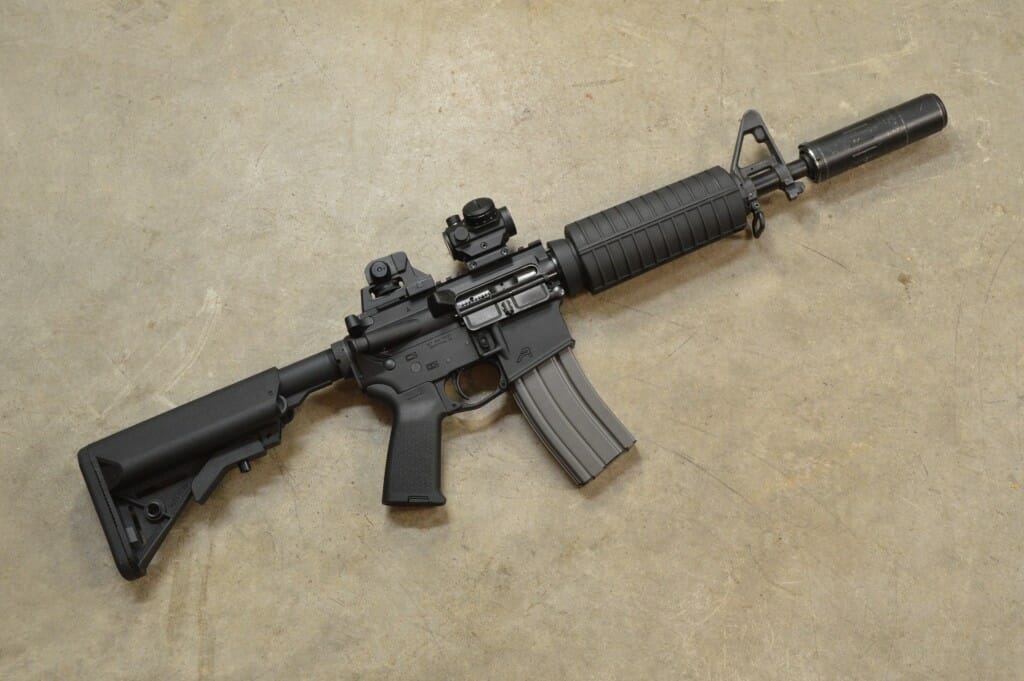Silencer Shop Authority: AAC Mini4 Review
It doesn’t take a whole lot of experience with silencers to figure out that even suppressed, most centerfire rifles are loud. Yes, shaving 30 decibels or so off the report of a rifle makes a huge difference, both from a health perspective and as a courtesy to other shooters and those nearby, but it often also means that you have to hang a relatively heavy and lengthy accessory from the end of the gun. On something like a short barreled AR-15, mounting a full size 5.56mm suppressor typically brings the rifle back up to Title I length (but does not change its NFA status), which might leave some wondering why the heck they paid the $200 to shorten the firearm in the first place.
Miniature, or shortened, silencers (particularly those made for 5.56mm) are many peoples’ answer to this predicament. They typically offer decent performance in a shorter and lighter package, keeping short guns short and longer rifles manageable. As the silencer market has grown in recent years, so too have the number of shortened options.
Advanced Armament Corporation’s Mini4 is one of the most tenured cans in the miniature 5.56mm realm. Released back in 2011, it’s a surprisingly popular suppressor that many have said sounds quieter than metered values indicate. As someone who finds long, heavy silencers to be annoying, I was excited to test these claims. Thanks to my friends at Silencer Shop, I recently spent some time with AAC’s diminutive 5.56mm suppressor.
Size & Weight
At just 5.3″ in overall length, the Mini4 is faithful to its moniker. Compared to most full size 5.56 cans, it’s positively tiny. If you plan to run the Mini4 on a short barreled rifle (SBR), it’s one of the few silencers that maintains the rifle’s compact feel and maneuverability. However, like most rifle suppressors, it is still 1.5″ in diameter.
Without its heavy mount, the Mini4 weighs just 13.8 ounces. I’ll gripe about this more in a bit, but AAC’s 51T mounts are far heavier than they should be. All of them weigh roughly twice as much as a standard A2/A1 birdcage and unfortunately, the added bulk negates some of the Mini4’s weight advantage.
Materials & Design
The Mini4 is an unquestionably rugged silencer. It features a 316L stainless steel tube and Inconel 718 baffles throughout. Some companies have moved to the slightly tougher 17-4 stainless steel for their tubes, but its advantages aren’t significant enough to make the Mini4 unappealing. 316L is proven and will be perfectly fine on a 10.5″ or longer barrel. Moreover, the Mini4 is full-auto rated for its native 5.56mm cartridge. Rounding the tube out is a black high temperature Cerakote finish.
From a design perspective, AAC’s Mini4 is rather straightforward. It is loaded with four conical baffles, three of which feature stepped ports in their bores. The steps help to create turbulence inside the tube and enhance performance, so I’m not quite sure why the blast baffle lacks the detail, but if I had to guess, AAC probably opted to forego the step on the blast baffle in order to maximize durability and longevity. Still, there is a small part of me that wonders if adding a stepped port to the blast baffle would do anything for performance.
Mounts
The Mini4 uses AAC’s well established 51-tooth ratcheting QD mounts, which are somewhat dated, but still work. They feature coarse threads followed by 51 teeth that engage a locking arm on the silencer as it is twisted onto the muzzle device. Unlike more recent designs, the 51T mounts don’t have a tapered surface to help secure and align the can. Furthermore, the locking arms on the AAC 51T suppressors tend to wear after repeated attachment and detachment, which can prevent them from properly mounting to the muzzle device. Because of the ATF’s inanity, replacing the locking lever can only be done by AAC.
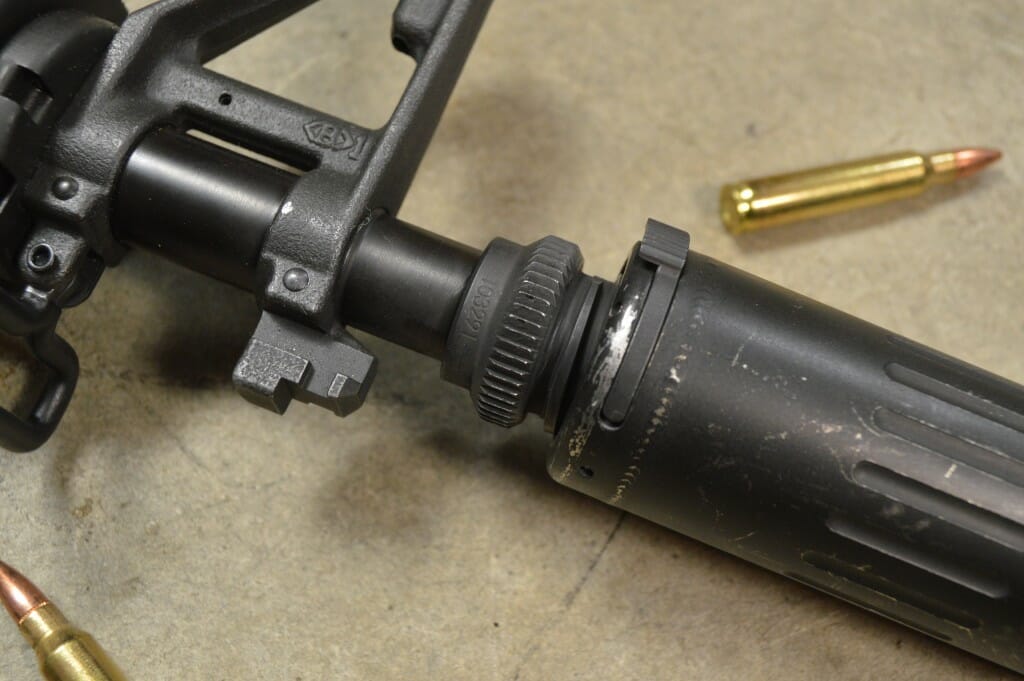
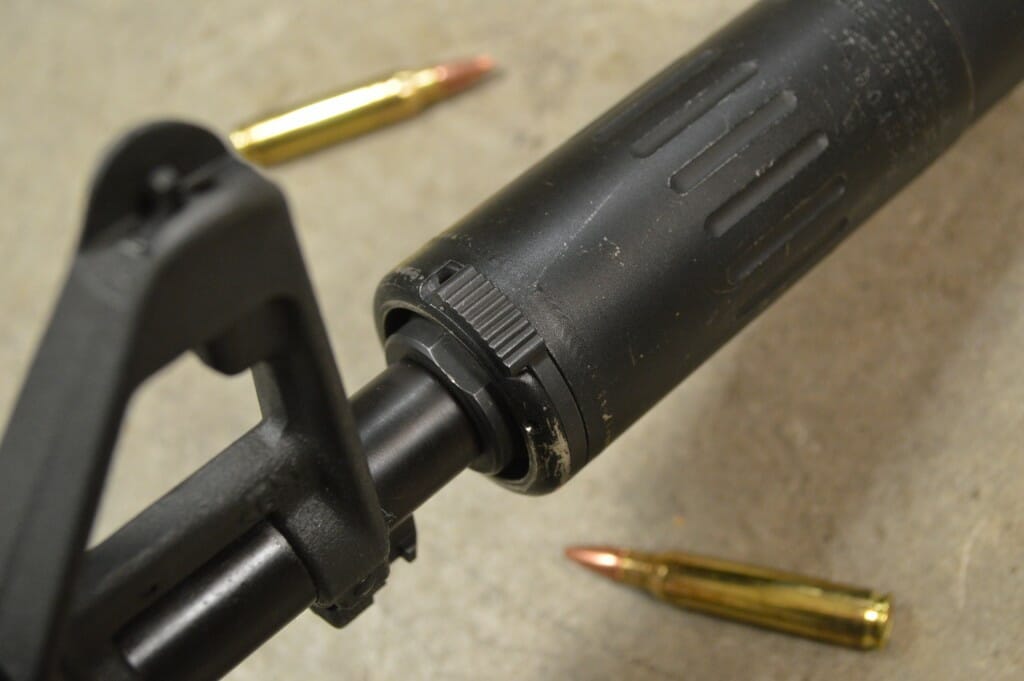
Silencer Shop sent the Mini4 over with AAC’s Brakeout 2 compensator. The Brakeout acts as both a muzzle brake and a flash hider and it works well in both roles, especially as a brake. However, on my SBR, it was VERY obnoxious when used without the silencer. While it virtually eliminated recoil, the concussion produced by its blast ports was substantial enough to leave me feeling bad for other shooters on the line. In a defensive scenario, I probably wouldn’t care at all, but the Brakeout can be relatively impolite at the range.
A last point worth mentioning with respect the the 51T mounts is that they are heavy chunks of steel. The Brakeout featured here weighs 4.2 ounces. Heavy muzzle devices effectively add weight to the suppressor and in this case, the 51T mounts offset some of the Mini4’s otherwise feathery disposition.
Range Report
Because the Mini4 is smaller than what most of us would consider a “full size” 5.56mm silencer, it is slightly louder than larger cans. However, ignoring the meter numbers, the difference isn’t all that great. Some have said that the Mini4 sounds better than it should and in my experience, that’s absolutely the case.
So why does the Mini4 sound better than it’s numbers? Answering this question requires that we understand where the gasses that the silencer aims to capture actually end up. A longer can, like my SilencerCo Specwar 556, more effectively captures or impedes the forward movement of expanding gasses generated by each round. However, the pressure that builds up inside the tube is considerable and if the gas can’t get out through the front of the device, it will take the next easiest exit – back into the barrel/gun. This is called backpressure and it not only speeds up the firearm’s cyclic rate (on semi- and full-auto guns), but it also causes additional noise at the ejection port and at other orifices throughout the rifle. In short, backpressure makes a suppressed firearm sound loud(er) to the shooter.
Conversely, a shorter silencer like the Mini4 does not capture as much of the gas that propels each bullet. The Mini4 is certainly louder at or near the muzzle than my Specwar (143 dB versus 133 dB according to Silencer Shop’s testing), but it actually outperforms some top 5.56mm silencers when metered at the shooter’s ear. Remarkably, the Mini4 beats its bigger (and well regarded) brother, the M4-2000, in at ear performance by around a decibel. Across the board, the Mini4’s at ear meter values are within a decibel or two of all leading 5.56mm suppressors. So while its diminutive size might limit its overall suppression capabilities, to many shooters it actually sounds every bit as good as other cans. At the range, I found this to be mostly true, with the only caveat being that the muzzle report from the Mini4 echoed more loudly off of nearby trees and terrain.
Beyond sound, the Mini4 was much more pleasant to shoot on my 10.5″ barreled AR-15 than my Specwar. Remember how I talked about cyclic rates and backpressure? The Specwar speeds up my rifle’s bolt enough to noticeably increase recoil. It also kicks more gas and debris back into the AR’s action. On the other hand, the Mini4 really only marginally increased bolt speed and I really wasn’t bothered at all by the gas that tried to escape through the back of the rifle’s upper receiver. Adjustable gas blocks or bolt carriers would render this point moot, but it is still noteworthy.
Virtually every silencer will alter a firearm’s point of impact (POI) to some degree. The Mini4 doesn’t violate this rule, but it also doesn’t have a great effect on POI. Mounted to my AR’s 10.5″ barrel, the silencer shifted each round’s POI down by around .5 to 1 MOA. The shift was just enough to be measured, but probably not substantial enough to matter all that much. Admittedly, a short, 10.5″ barrel has a mechanical advantage over longer pipes.
Conclusion
Because testing often shows that the Mini4 is louder than other 5.56mm options, people (especially those new to suppressors) often ignore it as a competitive option. My experience shows that it is actually an incredible performer, especially on SBRs where its short length and low backpressure help to retain the rifle’s handling and shooting experience. From behind the rifle, the Mini4 sounds every bit as good as top performing 5.56 cans and it weighs noticeably less. Unless you’re planning to use the Mini4 in a confined space, there’s a reasonable chance that you’ll barely notice its handicapped suppression.
AAC recommends the Mini4 for rifles with 14.5″ barrels and longer, as it can drop the muzzle report below 140 dB on those, but I think it works even better on even shorter barrels, like my 10.5″ AR-15. It’s just too bad that the mounts aren’t lighter weight and that AAC hasn’t adapted the Mini4 to their new 90T mounts. If I were in the market for another 5.56mm silencer, the Mini4 would absolutely be on my list.
Those interested in the Mini4 can find it at Silencer Shop for as low as $634, depending on local Powered By dealer pricing.
This has been a review of products sold by Silencer Shop. All opinions are my own.
An information security professional by day and gun blogger by night, Nathan started his firearms journey at 16 years old as a collector of C&R rifles. These days, you’re likely to find him shooting something a bit more modern – and usually equipped with a suppressor – but his passion for firearms with military heritage has never waned. Over the last five years, Nathan has written about a variety of firearms topics, including Second Amendment politics and gun and gear reviews. When he isn’t shooting or writing, Nathan nerds out over computers, 3D printing, and Star Wars.

